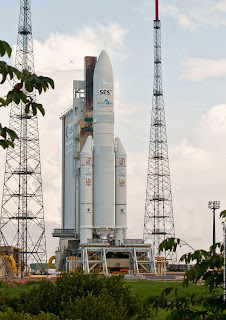Recently, the United States Government Accountability Office (GAO) has placed
‘Mitigating Gaps in Weather Satellite Data’ on their high risk list of government programs that are most in need of transformation.
In particular, the National Oceanic and Atmospheric Administration (NOAA) has identified that there is a
‘substantial risk of a gap in polar satellite data in the afternoon orbit, between the time that the current polar satellite is expected to reach the end of its life and the time when the next satellite is expected to be in orbit and operational. This gap could span from 17 to 53 months or more, depending on how long the current satellite lasts and any delays in launching or operating the new one.’
The polar satellites, together with their Geostationary counterparts, are
‘critical to weather forecasters, climatologists, and the military to map and monitor changes in weather, climate, the oceans, and the environment.’ The result of any gap would be reduced accuracy weather forecast, in particular surrounding extreme events such as hurricanes, storm surges and floods. The follow on effects would be to
‘place lives, property and our nation’s (United States) critical infrastructure in danger’. Interestingly, Polar satellites provided 84 percent of the data used in the main American computer model tracking Hurricane Sandy, showing just how critical they are.
What does this have to do with Australia I hear you asking?
Well, currently the
Australian Bureau of Meteorology receives the data from the NOAA Polar Orbiting Environmental Satellite (POES) Series of Satellites – precisely the satellites that have the predicted gap in service. A gap which is now on the U.S. GAO high risk list.
That means that Australia is likely to face exactly the same gap in data services, as we have long been a free-rider of the U.S. Satellite data. This data is also now integral to the accuracy of Australian weather forecasting. This means that Australia also faces reduced accuracy forecasts, particularly for extreme events, such as cyclones and floods, which Australia has been copping more than its fair share of recently. In particular, the Polar Satellites are critical to map the path of a cyclone – will it go out to sea, or will it make landfall? As in the U.S., reduced forecasting for Australia would also place lives, property and critical infrastructure at risk. You can imagine what an extra 24 or 48 hours’ notice does for the safety of lives and property when you have a category 5 cyclone making landfall.
So, where can Australia go from here?
We can hope that the existing satellites out-last their intended design lives, and hope that the U.S. can launch the follow on satellites, the Joint Polar Satellite System (JPSS) as early as possible. The U.S. also has launched the Suomi satellite, originally a technology demonstrator for the JPSS project, which is now being used operationally, and will help cover some of the gap if the technology survives.
Alternatively we can rely on other data sources – ESA in particular has a vast array of polar weather data that we may be able to source, however there would be costs in transitioning over to the new data, and we’d be equally reliant on Europe as we have been with the U.S.
In the U.S. a private company called
PlanetIQ is proposing to launch a 12-satellite constellation into Low Earth Orbit, to provide critical weather data. It is of course, expecting the U.S. government to pay for the service, so Australia would probably have to pay for the service itself if the U.S. government went down this path.
The issue facing Australia is one that has been warned about within the Australian space industry for a number of years. When we rely on foreign nations for our critical space needs, we have no ability to influence these programs, which, whilst being very cost effective, leaves us at the mercy of other nations and their decisions.
Australia should use this gap to take another look at our space needs, our space policy, and examine if Australia could play a modest, but effective part in securing our critical space needs. I'm certainly not suggesting that Australia goes it alone on its own weather satellites, however a small contribution to our partners such as the U.S., Japan, Europe and China may help secure their projects, and in turn, our data. We could even tie our contribution to a small amount of Australian work share, meaning any investment we make, would flow to Australian industry and jobs. Perhaps we could step up and build a small payload or instrument, focussing on one or two niche capabilities.
It is a classic example of where Australia needs to take back control of our space needs that are critical to our nation.
